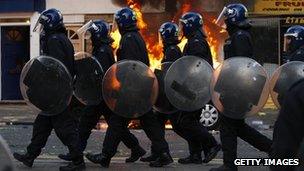Police 'need riot tactic rules', watchdog says
- Published
- comments

Some 299 officers were injured during the five nights of violence in England
Police should be given clear rules about when they can use water cannon and plastic bullets against rioters, a watchdog has said.
But officers could lawfully have shot arsonists in some cases during the summer rioting in England, the Inspectorate of Constabulary said.
Water cannon and plastic bullets could have been used in a "number of real scenarios", its report suggested.
MPs have said such tactics would have been "indiscriminate and dangerous".
Legal advice in the inspectorate's review of the August riots indicates that firearms can "potentially" be deployed where arson poses a threat to life, or of serious injury.
This could be justified given the "immediacy of the risk and the gravity of the consequences", said the report, which calls for a new framework for policing public disorder.
'Public support'
It suggested water cannon and plastic bullets could be considered to deal with rioters throwing missiles and petrol bombs, to stop "violent attacks on the public" and arson attacks, and also where fire and ambulance crews were under threat.
A survey of 2,000 people carried out in September had indicated public support for such measures, the report said.
It recognised water cannon as an "effective means of dispersal" which incur fewer injuries to the public in static and slow-moving scenarios but conceded they cost more than £1m each and needed to be deployed in pairs to be effective.
The report said that while current guidance already allowed the use of force, commanders were prevented from using some of the more forceful tactics due to a lack of training and resources.
Police also needed to outnumber rioters by between three and five to one if they are to effectively move forward, make arrests and disperse groups, the review said.
Chief Inspector of Constabulary Sir Denis O'Connor said it was necessary to raise "awkward issues" through the report.
Army role?
"Some new rules of engagement are necessary so the police can protect the public in confidence," he said.
He said the best option was to get officers on the streets as soon as possible but that a "proper debate" about tactics was needed to decide how to protect the public in the intervening period.
The inspectorate also revealed that discussions had taken place about support the military could provide in any future disorder, suggesting the Army could help in "logistical roles".
Sir Hugh Orde, president of the Association of Chief Police Officers (Acpo), said: "The challenge remains for operational police commanders to make critical decisions within volatile and fast-moving situations."
"When disorder occurs, the available tactics must include the necessary hard edge to resolve situations quickly and effectively."
Sir Denis O'Connor: "We have to hope for the best but prepare for the worst"
Sophie Farthing, from civil rights campaign group Liberty, said some of the tactics would represent "a very serious step" and it was important not to "sweep up the innocent with the guilty" when using devices like water cannon.
"There's certainly a lot for the police force... and the Home Office to consider before they start escalating for greater use of police powers of this kind," she said.
Jenny Jones, a Green Party member of the Metropolitan Police Authority, said: "Endorsing the use of live ammunition is an approval of the tactics of war on London's streets and implementing such recommendations would be madness."
'Insufficient numbers'
The review is the latest in a number of reports into the riots and its causes.
On Monday, a Commons Home Affairs Committee report said the policing operation to tackle the summer riots across England was flawed.
The Policing Large Scale Disorder: Lessons from the disturbances of August 2011, external said insufficient numbers of officers were initially deployed and police public disorder training was inadequate.
The perception that in some areas police had lost control of the streets was the most important reason disorder spread, it said, adding that flooding the streets with officers was what ultimately quelled the disorder.
But committee chairman Keith Vaz MP said he did not feel water cannon would have helped police in the riots and may have caused "even greater disorders".
The Metropolitan Police said it had outlined what it was doing to improve.
This month, a study by the London School of Economics and the Guardian newspaper, external found that 85% of 270 respondents cited anger at policing practices as a key factor behind the summer's unrest in English cities.
Meanwhile, the government-backed Riots, Communities and Victims Panel published its interim report, external, which found no single cause but that in many areas there was "an overriding sense of despair that people could destroy their own communities".
Chairman Darra Singh said the inspectorate had addressed some of the panel's key recommendations.
"It is very positive that... steps are being taken to help prevent future disorder on the scale seen in August this year," he said.
Violence broke out in Tottenham, north London, on 6 August, two days after the fatal shooting by police of 29-year-old Mark Duggan. Unrest spread across London and to other cities, including Manchester, Birmingham and Bristol over the following days.